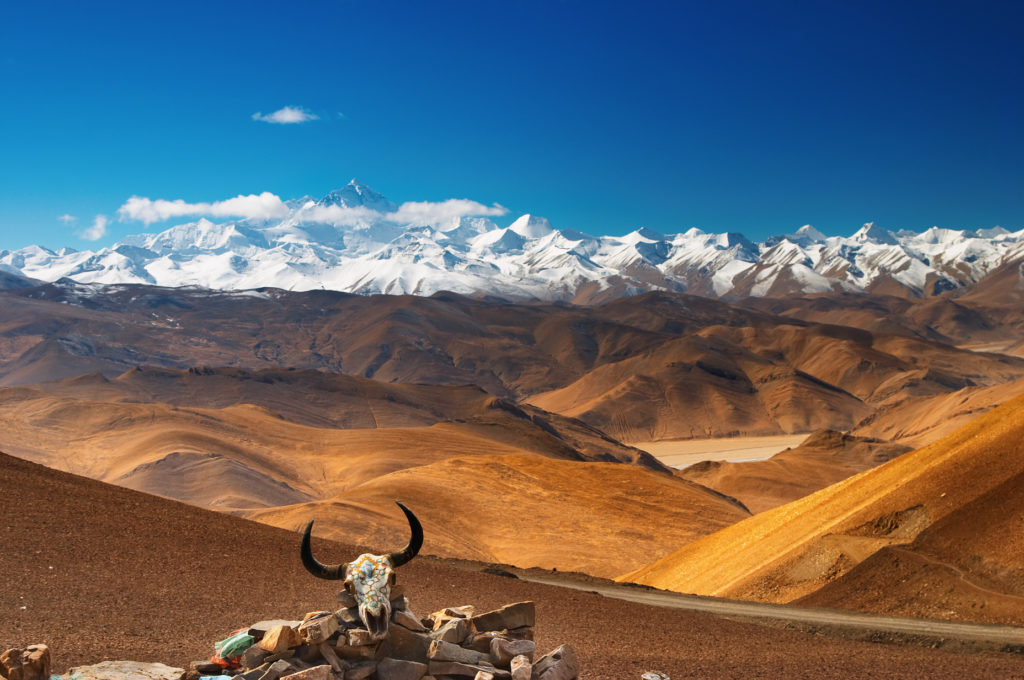
The amazing Himalaya! If you are traveling to Tibet, Bhutan or Nepal, no trip is complete without getting up close to at least one of the main peaks in the Himalaya. Himalaya tour information at: thelandofsnows@gmail.com
The Himalaya Mountains
For information about treks or tours to the Himalaya Mountains, send an email to: thelandofsnows@gmail.com
The Himalaya Mountains span some 2500 kilometers/1565 miles through northern India, Pakistan, Nepal, Tibet and Bhutan. Nine of the world’s ten highest peaks are located here, including Mt. Everest. The word Himalaya means “abode of snow” in Sanskrit. Many of Asia’s most important rivers have their sources in the Himalaya Mountains including the Indus, Ganges and Brahmaputra. The Himalaya contain the world’s 3rd largest deposit of ice and snow on the planet. Only the Antarctic and Arctic have more. Altogether, the Himalaya is home to around 15,000 glaciers.
Probably the most popular reason people go to Tibet and Nepal is to see the world’s highest and most spectacular mountain range. No trip to Tibet or Nepal is complete without seeing the Himalayas, particularly Mt. Everest. There is something about looking out to the world’s highest peaks that just can’t be described….it needs to be experienced! A misconception is that Everest or other peaks of the Himalaya’s are just right outside of Lhasa or Kathmandu and that is not true. The Himalayas are still a bit of a journey from the city! To reach the Nepal-side Everest Base Camp, you will have to trek for around a week from the village of Lukla. To reach the Tibet-side base camp of Everest, you will need at least 2 or 3 days to acclimatize in Lhasa along with a further 2 days of driving.
Having lived on the Tibetan Plateau for the past 14+ years, I have been fortunate enough to travel through large portions of the Himalaya in Tibet, Bhutan, India and Nepal. This post will highlight some of my favorite views of the Himalayas as well as information on how to visit.
Mt. Shisha Pangma, pictured above, is the 14th highest mountain on earth and the highest mountain that is located entirely within Tibet. Shisha Pangma is easy to reach. A good view of the peak can be seen from the Tong La Pass along the Friendship Highway. The Tong La Pass rises to 5150 meters and on a clear day, the views of the mountain are great.
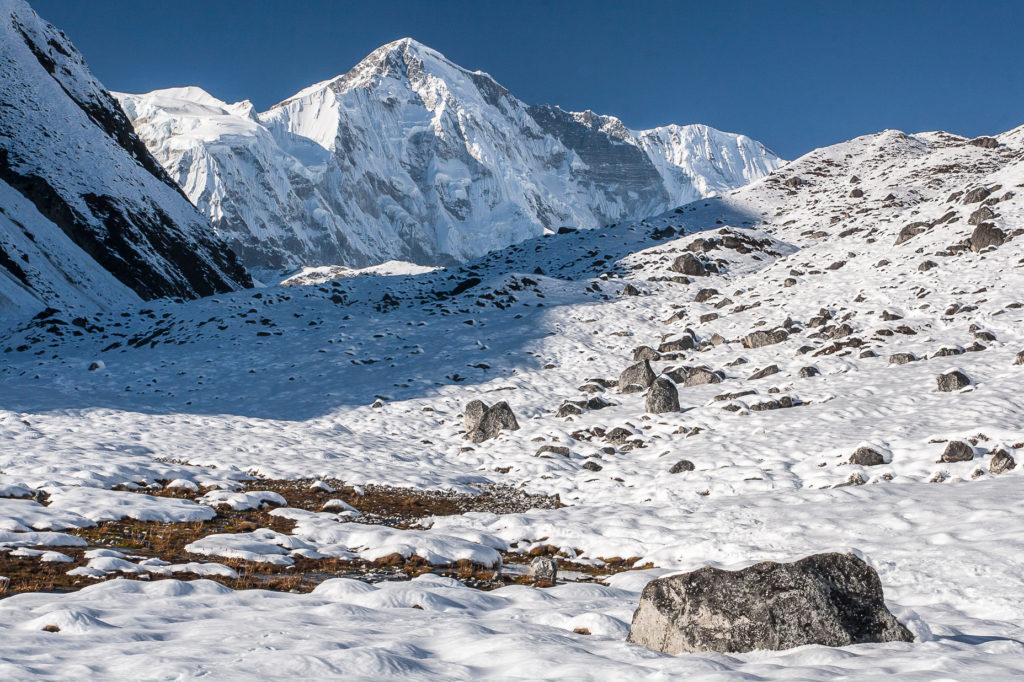
Cho Oyu viewed from near Gokyo, Nepal
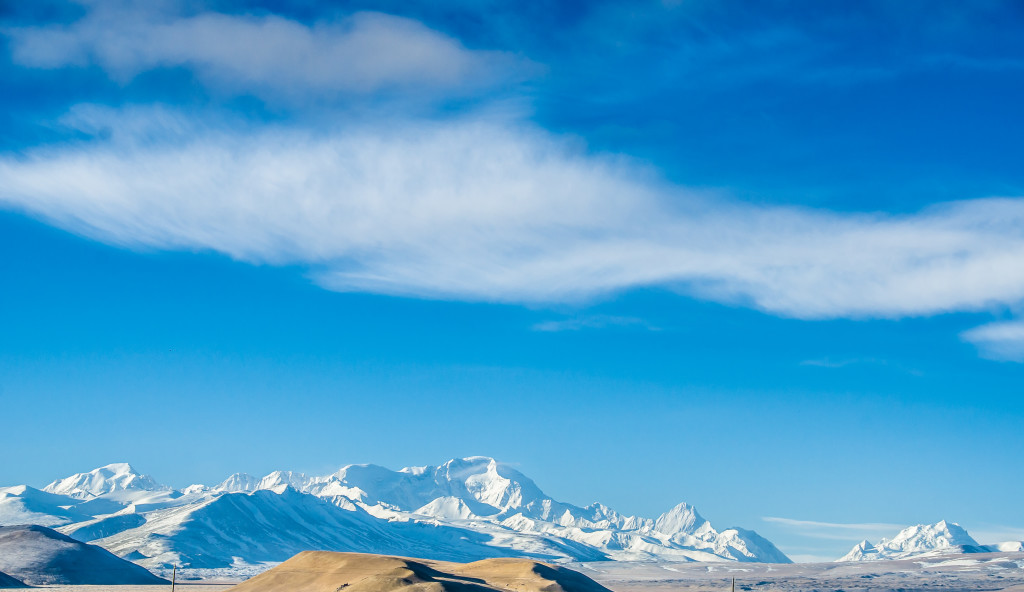
View of Cho Oyu, 6th highest peak, from Old Tingri, Tibet
Cho Oyu is the 6th highest peak on the planet and rises to 8201 meters/26,906 feet. It lies along the border of Tibet and Nepal, though it is climbed from the Tibet side. Excellent views of Cho Oyu can be had from Gokyo, a small village in the Himalaya of Nepal that can only be reached by trekking. The Gokyo Trek is one of the most beautiful trekking routes in all of the Himalaya. Starting and ending in Lukla, it takes around 12 days to complete and offers stunning mountain views.
The town of Old Tingri, Tibet also offers a good view of this giant peak.From Old Tingri, you can drive 3 hours to reach the base camp from where expeditions up the mountain begin. Of the 14 peaks on the planet that rise above 8000 meters, Cho Oyu is considered the least difficult to climb. Cho Oyu was first summited in October 1954.
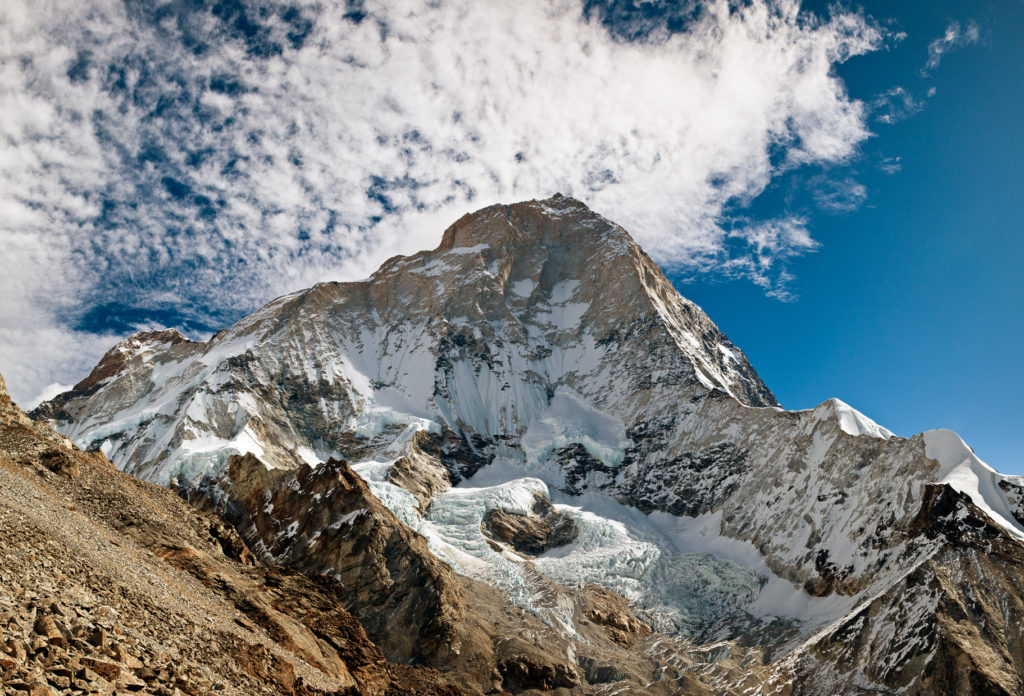
Makalu, the world’s 5th highest peak
Makalu is one of the most beautiful of the 14 peaks that rise to 8000 meters or higher. It is located 19 kilometers/12 miles away from Mt Everest and sits along the Tibet-Nepal border at an elevation of 8485 meters/27,838 feet. It was first summited in 1955.
Mt Everest
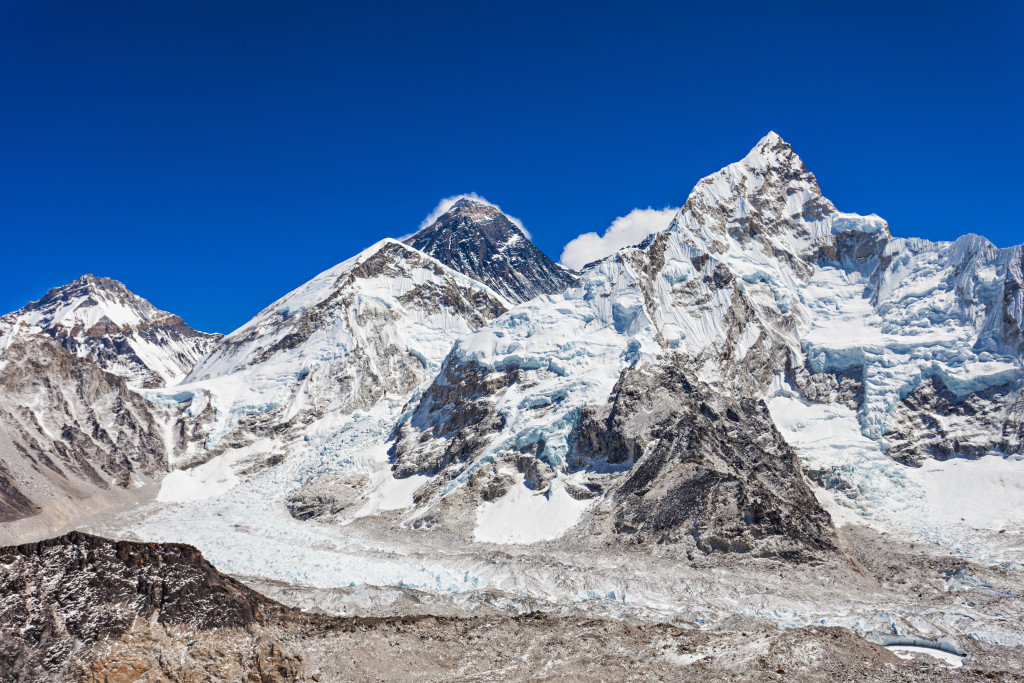
Everest and other Himalaya giants viewed from Kala Patthar in Nepal
Everest can be viewed from both the Nepal side of the Himalaya and the Tibet side. Both sides are amazing. From the small mountain of Kala Patthar in Nepal, you get a sweeping view of Everest along with Changtse, Nuptse and Pumori. In my opinion, there is no better Himalaya view than Kala Patthar! To reach Kala Patthar, you need to trek starting from the small village of Lukla. From Lukla, it will take around 7 or 8 days of trekking to reach Gorak Shep, the nearest village to both Kala Patthar and the Nepal-side Everest Base Camp. From Gorak Shep, it is a steep 90 minute to 2 hour hike up to Kala Patthar, elevation 5545 meters/18,192 feet. Be advised that from the Nepal-side Everest Base Camp, you cannot actually see Everest, though nearby Kala Patthar has great views.
If you are looking for a clear, unobstructed view of Everest, the view from Tibet is where it is at! Unlike the Nepal side, no trekking is required to reach the Tibet side of Everest. There is a road leading all the way to base camp at an elevation of 5200 meters/17,060 feet. From here, you get an excellent, clear view of the world’s highest peak. It is important to take time to acclimatize before setting off for the Tibet-side base camp. I recommend taking at least 2 or 3 days to acclimatize in Lhasa before going to higher elevation. To safely reach the Tibet-side of Everest, I recommend taking 5 to 7 days.
For information about trekking in Nepal or Tibet, email me at: thelandofsnows@gmail.com
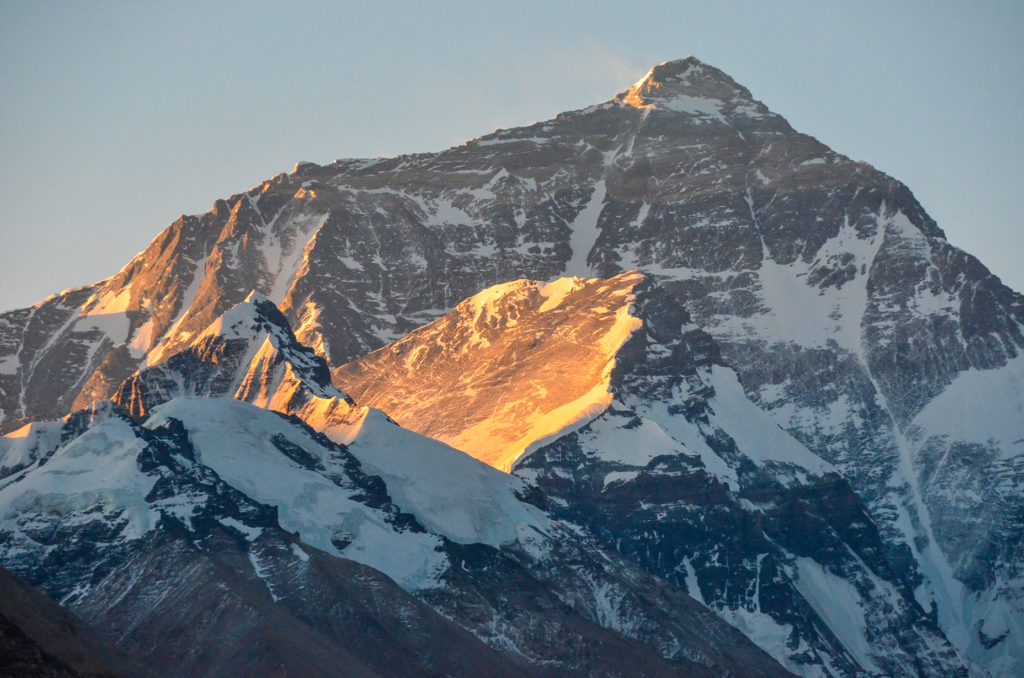
The sunrising on the Tibet-side of Everest. Photo was taken from Rongphu Monastery.
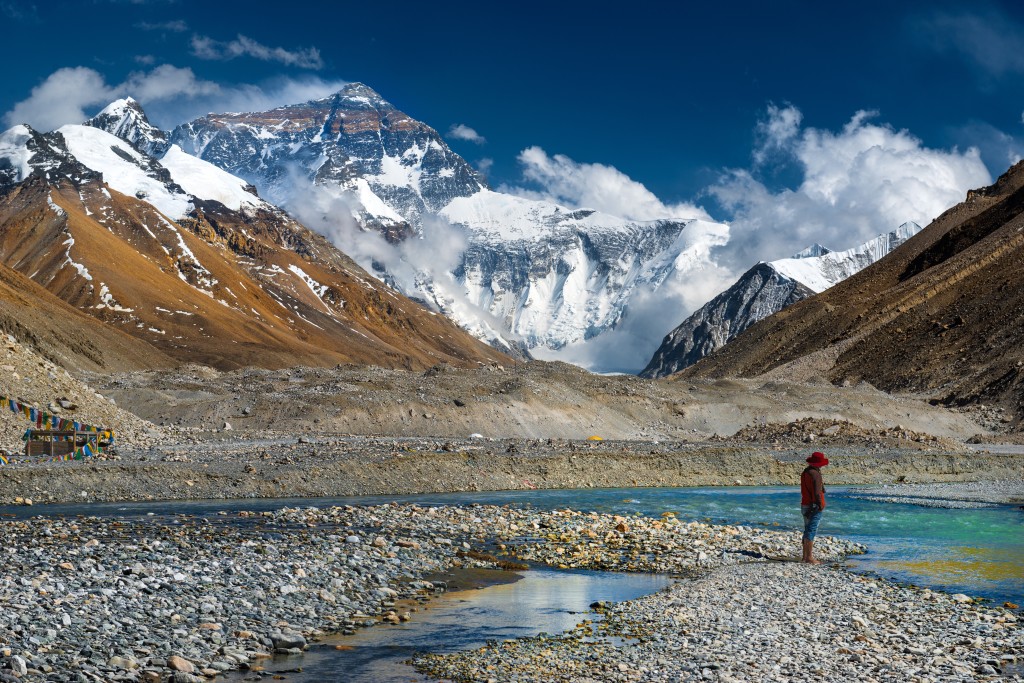
Everest viewed from near the Tibet-side base camp
Trekking in Nepal
Of the 5 countries where the Himalaya Mountains are found, the best trekking is found in Nepal, in my opinion. Whether you are trekking in Dolpo, Upper Mustang, Langtang, Annapurna or the Everest Region, you are going to have a fantastic adventure. Of all the trekking regions of Nepal, the most popular is the Annapurna Region. The starting point for trekking Annapurna is the city of Pokhara, located in central Nepal. The Annapurna Region offers treks ranging from 4 days to Poon Hill to 18 days if you do the complete Annapurna Circuit Trek.
The second most popular trekking region is the Everest Region. There are several excellent treks to take including the Everest Base Camp Trek (13 to 15 days in length), Gokyo Trek (12 days) and the prestigious Three Passes Trek (18 to 20 days in length). The main starting point for trekking in the Everest Region is the village of Lukla. Lukla can be reached by flight from Kathmandu.
The best months to trek in Tibet are mid March through mid May and again from early October through early December. The monsoon months of June, July and August are not deal for trekking. For more information about trekking in Nepal, send me an email at: thelandofsnows@gmail.com
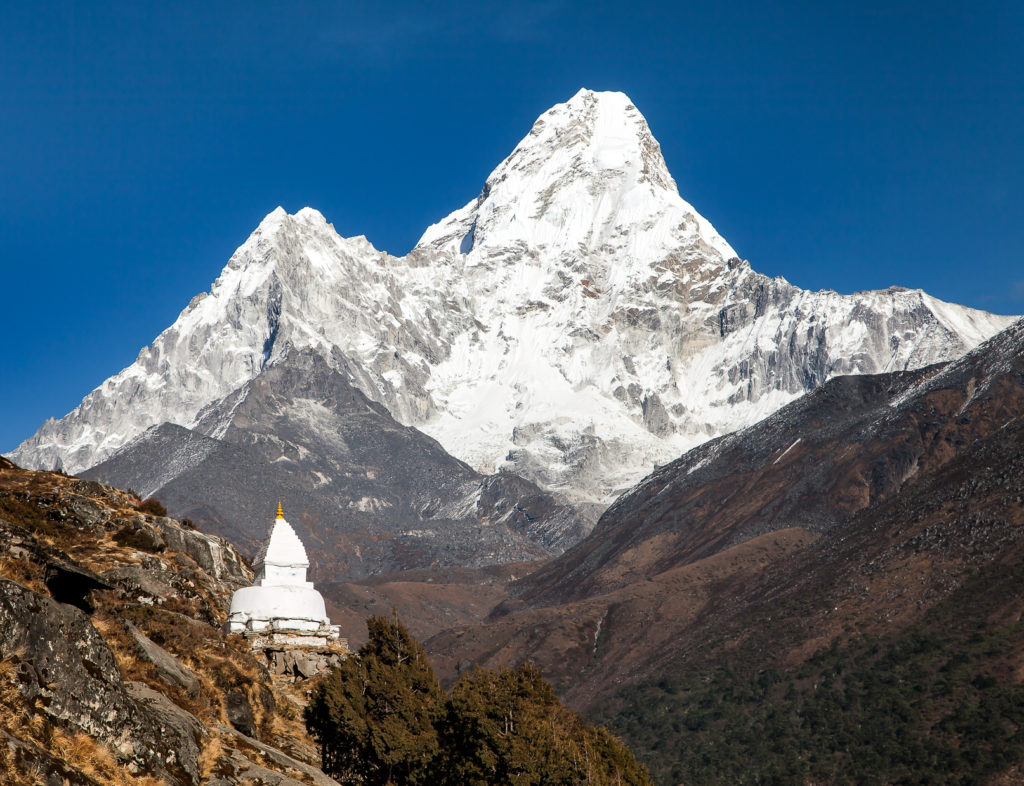
Ama Dablam is one of the most beautiful Himalayan peaks in Nepal. This is a short trek above the town of Namche Bazaar.
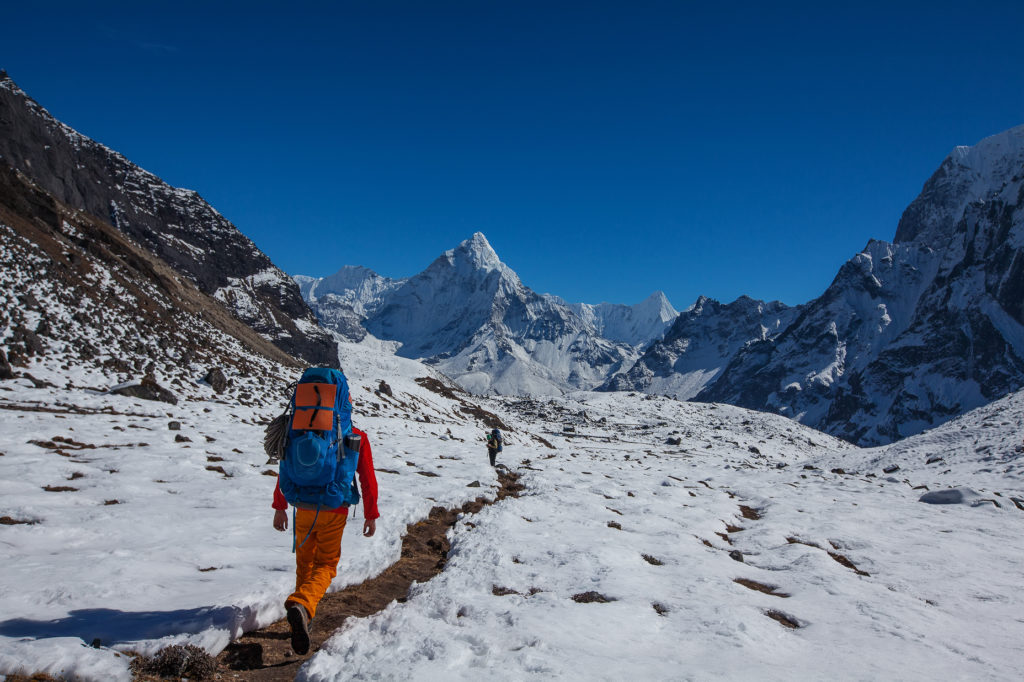
Trekking in the Everest Region of Nepal. This is along the Three Passes Trek below the Cho La Pass.
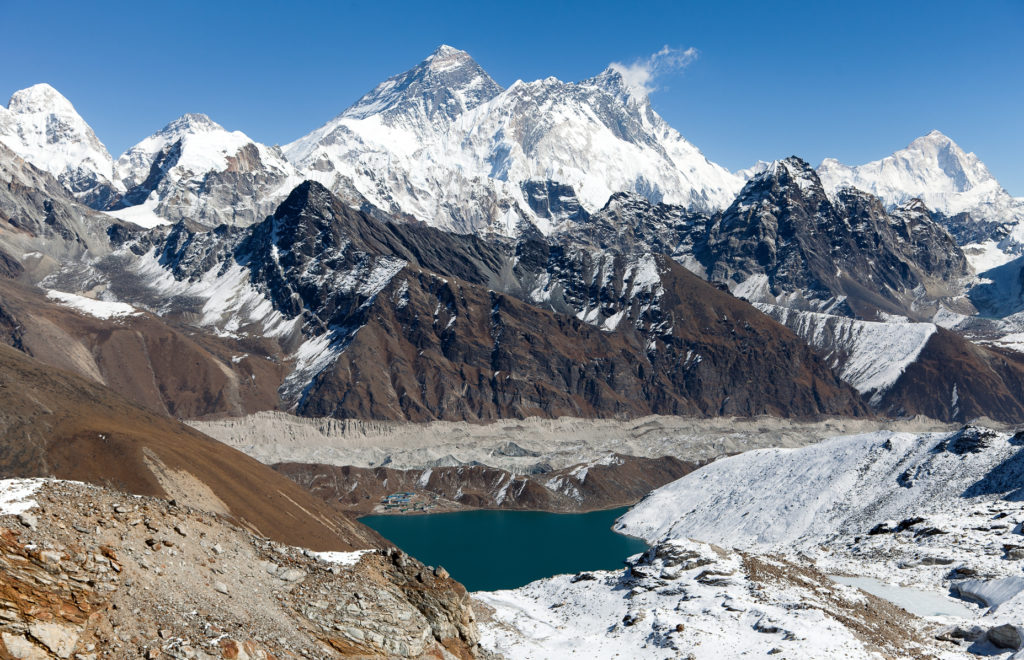
Everest and Gokyo Lake viewed from the Renjo La Pass in Nepal
Ladakh and Little Tibet
Ladakh is located in far northern India and is often referred to as “Little Tibet”. The culture, language and religion of the Ladakhi people are all very similar to what is found in Tibet. The Himalaya Mountains are found throughout Ladakh and offer great trekking and climbing. The starting point in Ladakh is the small town of Leh, which serves as the capital. You can reach Leh by road in the summer months and by flight from Delhi all year round. Read the following link to learn How to Travel to Ladakh
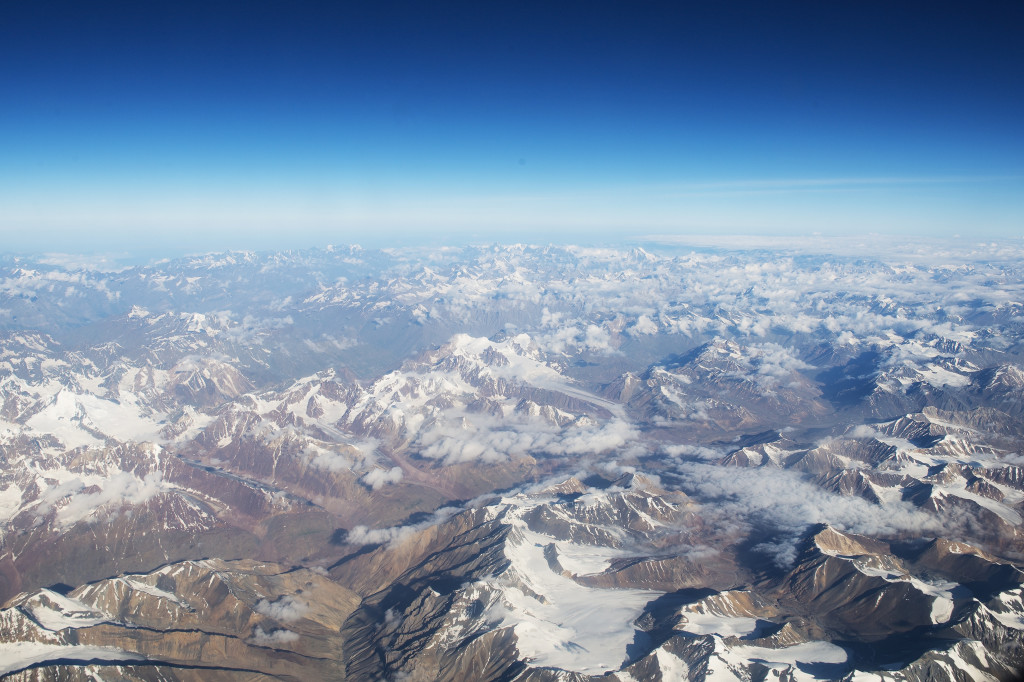
Flying over the Himalaya
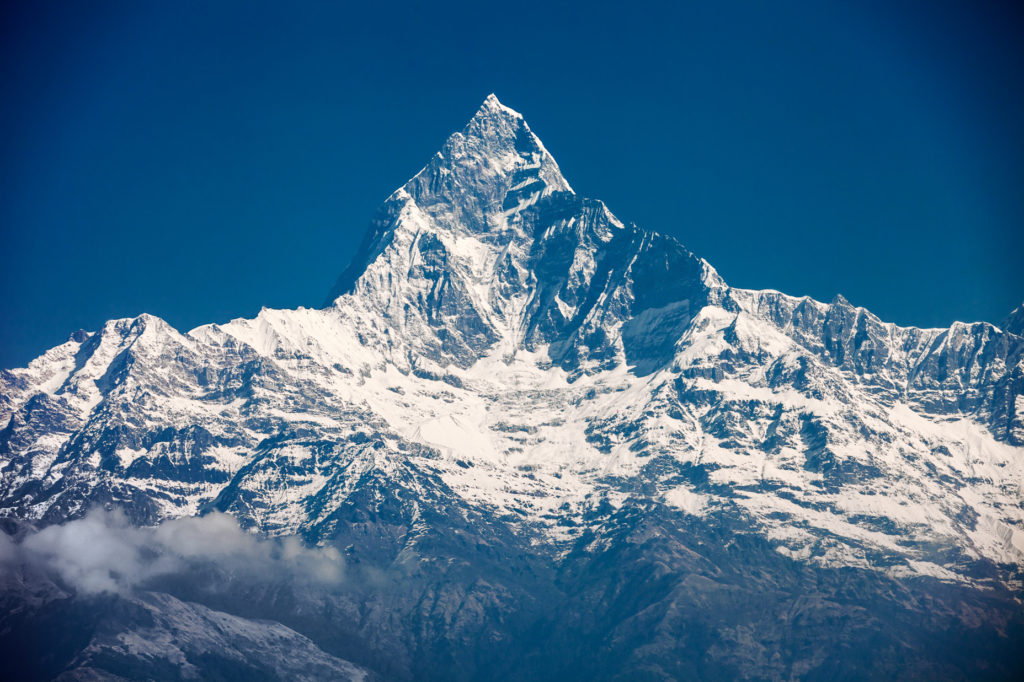
Machapuchare is located in the Annapurna Region of the Nepal Himalaya
Bhutan
Bhutan is a tiny landlocked nation located in the eastern Himalaya. The country has a population of only 750,000 people. Like Tibet, all foreign travelers to Bhutan must be on a pre-arranged, organized tour through a travel agency. Bhutan has an amazing preserved Buddhist culture, beautiful architecture, great mountain treks and some great views of the Himalaya. For detailed information on How to Get to Bhutan, please read this link: How to get to Bhutan
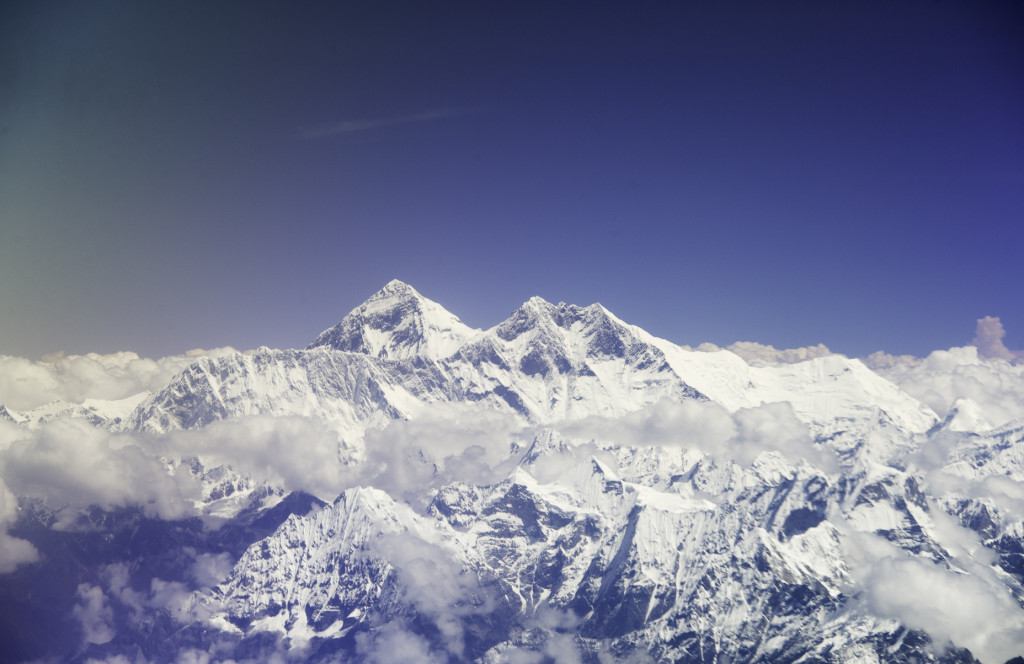
The view of Everest on the flight to Bhutan
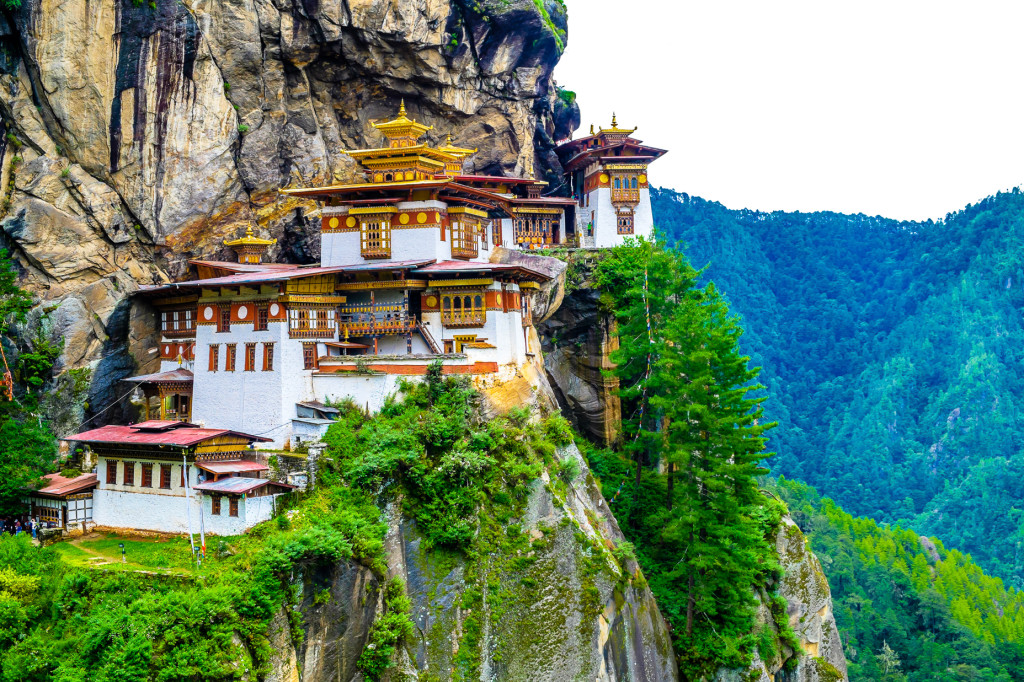
Taktsang Monastery in Bhutan is one of the most iconic places in the Himalaya
More Information on the Himalaya Mountains
I have spent nearly 15 years traveling and living in the Greater Himalaya Region of Asia. I have traveled extensively across Tibet, Bhutan, Ladakh, Sikkim and Nepal and am happy to answer any questions you have about trekking, climbing and traveling in these areas. I can arrange high quality tour or put you in contact with reputable local agencies. For more information, send me an email at: thelandofsnows@gmail.com
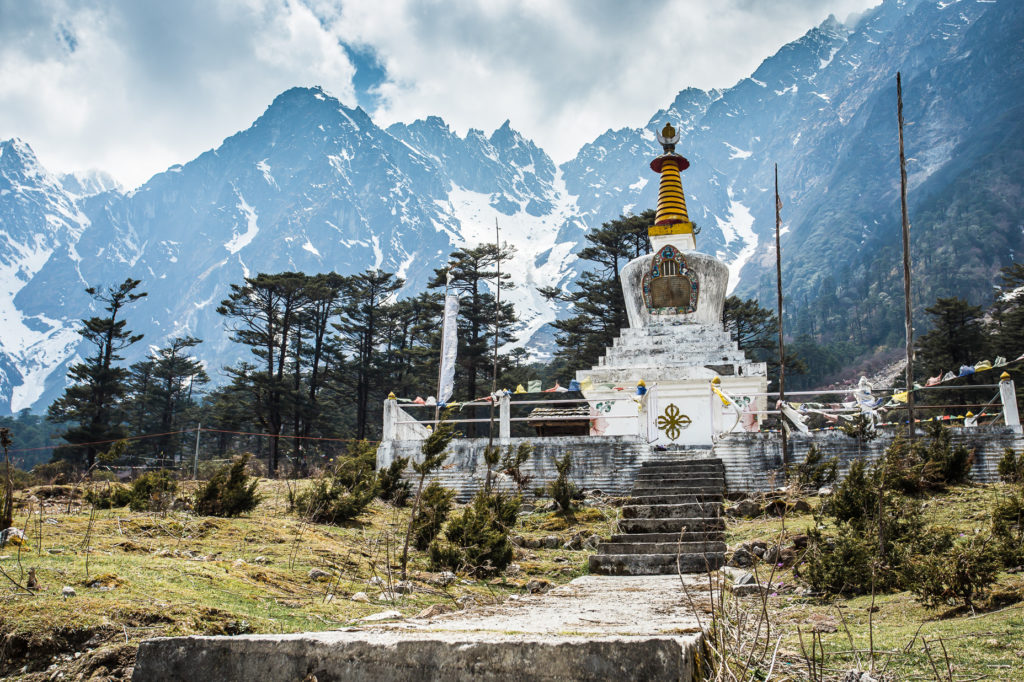
The Himalayas viewed from Sikkim in northern India
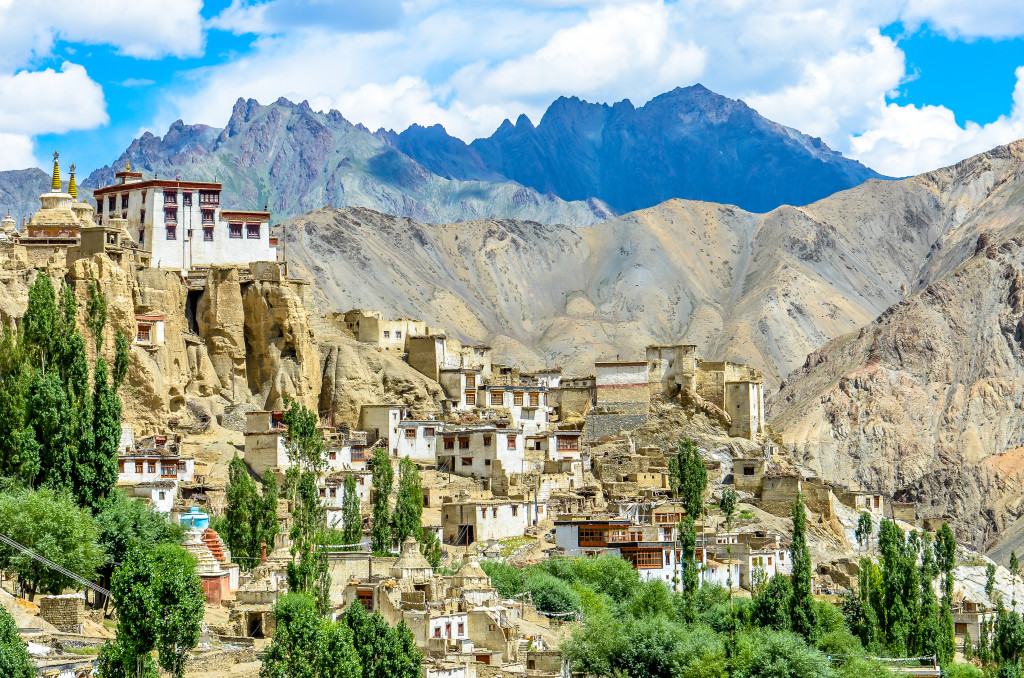
Lamayuru in Ladakh, India. The Himalaya rise in the distance.

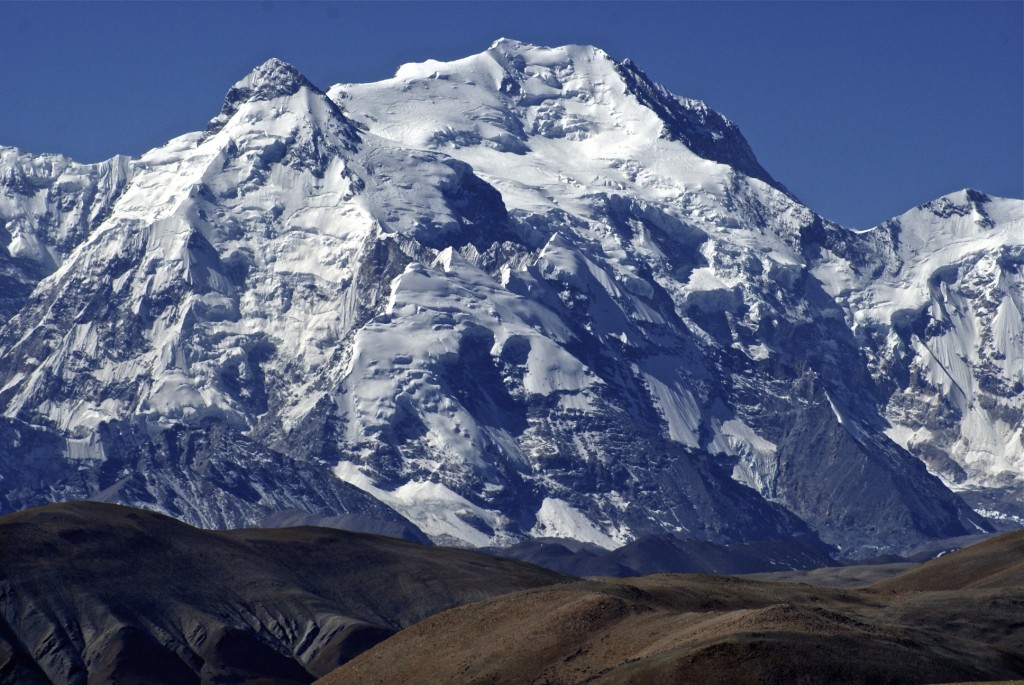
Pingback: 2013 Tibet Travel Updates « The Land of Snows
Pingback: 2014 Tibet Travel Regulations « The Land of Snows
Pingback: 2015 Tibet Travel Regulations | The Land of Snows
I’m really keen to stay in Tibet or Nepal (preferable in high altitude) for a change from my day to day activity, 1 – 3 months. Do you know how do I start this? I wouldn’t mind to do some volunteering work as well. I also keen to do some trekking or even climbing.
Is this safe for a alone traveller girl?
Thanks
Staying in Tibet for 1 to 3 months will cost a fortune as you will have to have a guide, private vehicle and driver for the duration of your stay. I recommend going to Ladakh in northern India where you can live there for a small fraction of the cost compared to Tibet.
Lobsang